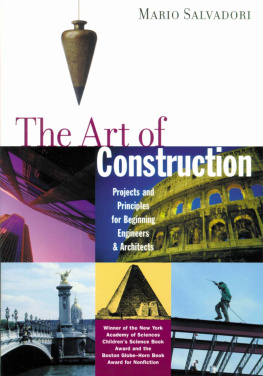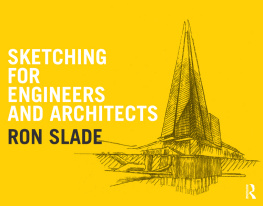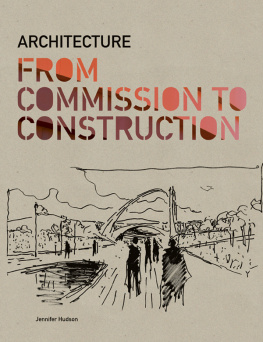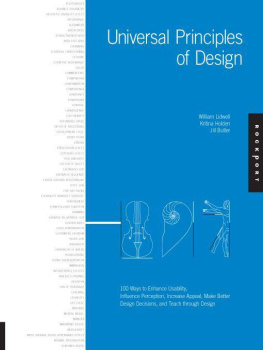Library of Congress Cataloging-in-Publication Data
Salvadori, Mario George, 1907
The art of construction: projects and principles for beginning engineers and architects / Mario Salvadori; drawings by Saralinda Hooker and Christopher Ragus. 3rd ed.
p. cm.
Rev. ed. of: Building. New York: Atheneum, 1979.
Summary: Explains how tents, houses, stadiums, and bridges are built, and how to build models of such structures using materials found around the home.
ISBN 978-1-55652-080-8
1. Structural analysis (Engineering)Juvenile literature. 2. Building materialsJuvenile literature. [1. Structural analysis (Engineering) 2. Building materials. 3. Models and modelmaking. 4. Handicraft.] I. Hooker, Saralinda, ill. II. Ragus, Christopher, ill. III. Salvadori, Mario George, 1907Building. IV. Title.
TA634.S23 1990
624.1 771dc20
89-49406
CIP
AC
For Niccolo and all my other young friends who keep asking me why buildings stand up
Text 1990 by Mario Salvadori
Drawings 1979 by Saralinda Hooker and Christopher Ragus Originally published as Building: The Fight Against Gravity, Atheneum, 1979. First paperback edition, Macmillan, 1981.
All rights reserved
Third edition
Published by Chicago Review Press, Incorporated
814 North Franklin Street
Chicago, Illinois 60610
Printed in the United States of America
ISBN 978-1-55652-080-8
25 24 23 22 21
CONTENTS
Index
PREFACE TO THE THIRD EDITION
THE LAWS GOVERNING the construction of structures do not change with the passing of years or centuries; they are basic laws of nature. Yet I find it necessary to add a preface to this third edition of my book because of the experience I have acquired over the last fifteen years in the schools of New York City and other parts of the United States.
After teaching architectural structures at Princeton and Columbia Universities for many years, I introduced in 1975 a special school program to excite greater interest in mathematics and science in young students. Many thousands of youngsters in junior high and high schools have been exposed to the program since then, and the study of architecture and structure has attracted them to subjects they previously considered obnoxious. Our program has stimulated them to stay in school and to perform well in a wide range of subjects. The Art of Construction is one of the tools we use to present our program to grade school students. I feel it is worthwhile for parents and teachers to realize that a simple book on architecture may help solve one of the problems that concerns educators all over the country.
Finally, I must add that although The Art of Construction was written for youngsters, it seems to be of great interest to older youngsters as well, among them some of the architects I serve as a professional structural engineer. The third edition of this book has been brought up to date on the few data that have changed with time and may be read as an original work.
Mario Salvadori
New York, New York
January 1990
ACKNOWLEDGMENTS
I wish to express my deep gratitude to the children of Harlem, who joyfully started me on a new career
and
to Pearl Kaufman, who put the book together so many times with love, patience and skill.
1  | From Cave to Skyscraper |
THIRTY THOUSAND YEARS AGO, people roamed from place to place hunting animals for food and looking for wild plants to eat. As they were always moving, they did not build houses. They slept under the stars, got wet under the rain, sweated under the sun, and cooked their meals over open wood fires. Much later on, they began to put up shelters, tents made of animal skins, and tried to protect themselves from the weather. If they were lucky and roamed in mountainous areas, they might find caves where they could cook and sleep. Caves were better places to live in, but tents had the advantage of being easily moved. If the supply of animals or wild plants ran out, men and women could pull up stakes and set up housekeeping where there was more food. They literally pulled up stakes because they had found that, without ropes anchored to the ground, their tents could be blown away by the wind. So they fought the force ), just as we do today when we go camping.
Of course, for people to be able to live under the tent, a pole made out of a tree branch had to support the top at the center, and the taller the pole, the taller the tent. It would have been comfortable to use poles tall enough to allow men to stand up under the tent, but it was not easy to do this.

If the pole were tall and thin it might bend and collapse under a high wind pressure or when the ropes were pulled too hard (). If the pole were thick, it would not collapse but would be heavy and hard to carry. The tent people had to be satisfied with thin, short sticks that were both light and stiff, so they could not stand up straight under their tents.
To make sure the wind would not pull out the stakes they also set heavy stones on the skin all around the bottom of the tent. The tent wouldnt blow away unless the wind could lift the weight of the stones and then pull out the stakes. The heavier the stones, the stronger the wind had to be to move them.
A few more thousands of years went by, and about ten thousand years ago people slowly began to learn a new way of getting food. Instead of eating wild plants, like rice that grew by itself in certain spots, they learned to plant vegetables, wheat, barley, millet and rye, to water them, to tend them, and to grow enough to feed their families without ever moving camp. At the same time they learned to catch wild animals and to feed and keep them in captivity. They domesticated dogs, asses, oxen, horses, and turkeys and thus provided meat as well as vegetables and grain for themselves and their families without having to be on the move all the time. Humankind had discovered agriculture.
When early men and women had to break camp often and carry tents on their backs, they could not have very comfortable homes. But once they had found ways of staying in one place, they started to think of building shelters that were larger, stronger, and more comfortable than tents. As they learned to farm, they slowly became builders and their houses became larger and taller.

Each family had its own permanent home. In cold climates it was usually made out of logs or stones set one on top of the other. In moderate climates it was built of mud mixed with straw, a material called adobe, while in hot climates it was made out of wood poles and thatched roofs (). Gradually people learned how to use the materials they found in nature, such as stone, wood, and vegetable fibers.




Next page















